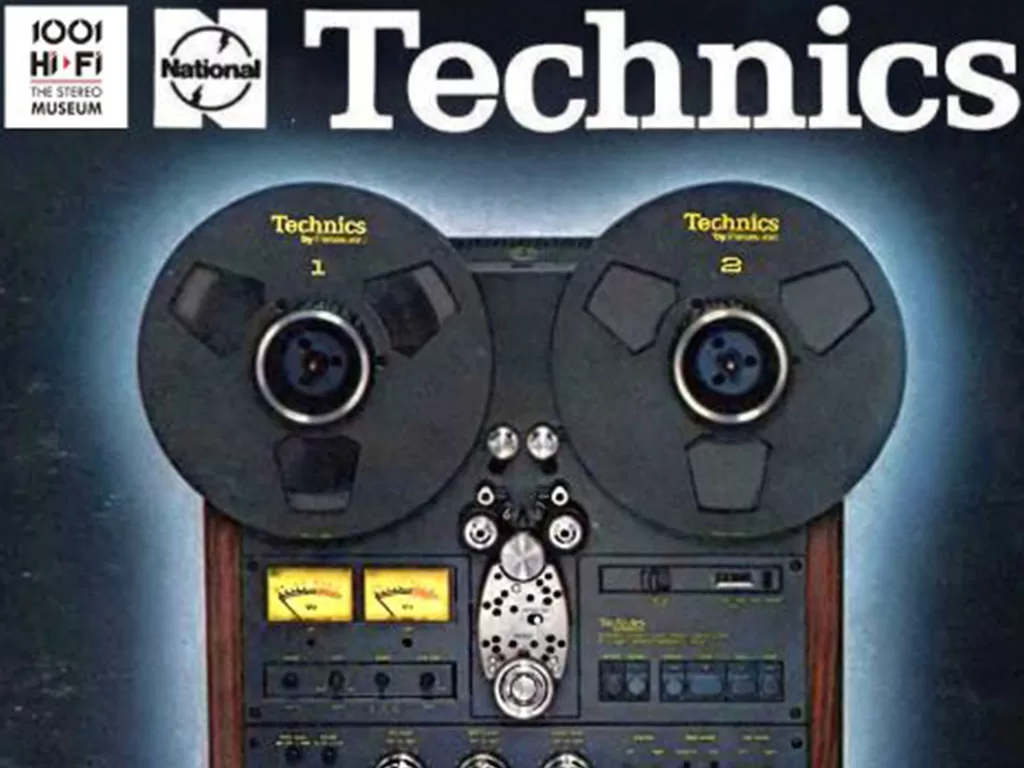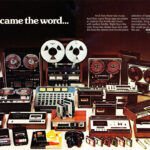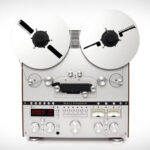Tape Recorders Are a Fascinating Invention
They have completely revolutionized the way we record and play back sound. In this section, we provide an overview of tape recorder technology and the operation of tape recorders, with a special focus on reel-to-reel models.
We explore how these devices capture and reproduce sound. We will see why they are so important in the history of audio technology. The rise of tape recorders in the 1950s improved music production and sound quality, leading us to the question: how does a reel-to-reel tape recorder work?
Key Points
- Overview of tape recorder technology
- Understanding how tape recorders work
- Focus on reel-to-reel tape recorders
- Impact of tape recorders on music production
- Historical significance of this technology
Introduction to Tape Recorders
Tape recorders have completely changed how we record and play sound. They emerged from the need for reliable audio recording technology, giving artists and producers in the music, radio, and film industries a variety of possibilities. This introduction shows the importance of tape recorders in the development of audio technology.
The use of tape recorders began in the 1950s when they became increasingly available to consumers. This opened up opportunities for home recordings and amateur productions. People could showcase their creativity without needing a professional studio.
Audio recording technology has since evolved significantly, moving from analog to digital formats. However, tape recorders remain beloved by audiophiles and professionals who appreciate the unique sound and quality of analog recordings. Tape recorders are now indispensable in music production, radio broadcasts, and the archiving of audio content.
| Period | Development | Impact on Industry |
|---|---|---|
| 1900-1950 | Inception and evolution of tape recorders | Professional recordings only available |
| 1950-1970 | Consumer accessibility | Growth of home recording |
| 1970-2000 | Rise of digital recording technology | Changing market and preferences |
| 2000-present | Revival of analog technology | Mutual appreciation of analog and digital techniques |
History of Tape Recorders
The history of tape recorders began in the 1930s when the first models were introduced. Initially, they were wire recorders, but later transitioned to tape recorders.
The shift to tape was a significant milestone in the development of recording devices, with new techniques laying the foundation for modern recording equipment.
The establishment of Ampex was a critical moment. This company played a significant role in the advancement of tape recorder technology. The first commercial tape recorders were released in the 1950s, making them popular in the media industry.
In the 1960s and 70s, tape recorders became easier to use, making them more accessible to a broader audience. Brands like Sony helped refine the technology further.
The history of tape recorders shows how they have evolved, from the earliest experiments to now. Their development has had a major impact on how we capture and experience sound.
Types of Tape Recorders
There are various types of tape recorders, each with unique features and applications. You’ll find reel-to-reel, cassette decks, and portable models, each offering its own advantages.
Reel-to-reel tape recorders provide top-tier sound quality, making them great for music producers and audiophiles. They use large reels and deliver a rich sound.
Cassette decks are user-friendly and portable, ideal for everyday use. They are popular among those who record or play music.
Portable tape recorders are highly convenient for on-the-go use, perfect for journalists and musicians who need to record quickly and effectively.
Choosing the right tape recorder depends on your specific needs. Here’s an overview of the different types and their features:
| Type of Tape Recorder | Sound Quality | Usage | Ideal For |
|---|---|---|---|
| Reel-to-Reel | Excellent | Professional | Music producers, audiophiles |
| Cassette Deck | Good | Daily use | Hobbyists, general use |
| Portable Tape Recorders | Good | Mobile | Journalists, musicians |
How Does a Reel-to-Reel Tape Recorder Work?
A reel-to-reel tape recorder captures and plays back sound using magnetic tapes. It’s essential to understand the basic principles and components. Let’s take a closer look at the key aspects that make these machines work.
Basic Principles of Operation
At the heart of a reel-to-reel is the process of converting sound waves into magnetic signals. The recording device converts the sound waves using a recording head that translates the signals into electrical impulses, which then magnetize the tape.
To play back the recorded sound, the tape runs past the playback head, which converts the magnetic signals back into sound waves, allowing you to hear the recorded audio.
Components of a Reel-to-Reel Tape Recorder
A reel-to-reel tape recorder consists of several important parts. These components work together to allow the device to function. The key components include:
- The reels: These hold the magnetic tape on which the recording takes place.
- The recording head: Converts electrical signals into magnetic information.
- The playback head: Reads the magnetic information and converts it back into sound.
- The motor: Moves the tape at the right speed, crucial for quality recording and playback.
- The transport mechanisms: Ensure the tape moves smoothly through the recorder.
Tape Recorder Technology
Tape recorders use advanced technology to capture and play back sound. We’ll explore the basics of magnetic tape and the recording process and also look at the differences between digital and analog recording.
Magnetic Tape and the Recording Process
Magnetic tape is central to the recording process. This tape has a magnetic coating that allows it to store sound as a magnetic pattern. A recording head detects these sound waves and writes them onto the tape.
The recording process is precise and reproduces the original sound quality accurately.
Digital vs. Analog Recording
There are significant differences between digital and analog recording. Analog recording, like with magnetic tape, gives a warm sound that many people enjoy. Digital recording is more precise and easier to edit.
Choosing between the two depends on the desired sound profile and technical requirements.
Spooling and Rewinding the Tape
Spooling a tape recorder is essential for proper use and maintenance. By employing different techniques, you can improve performance and extend the lifespan of the tape.
Spooling Techniques
There are several techniques for spooling a tape recorder. Here are some important ones:
- Spool slowly to avoid damaging the tape.
- Use the automatic spooling function if available.
- Monitor tape tension during spooling to ensure smooth operation.
These techniques help you not only spool efficiently but also maintain good sound quality.
Impact of Spooling on Sound Quality
How you spool your tape affects the sound quality. Regular and careful spooling prevents jolts and interruptions, enhancing the listening experience.
Proper spooling also protects the tape from wear, extending its life.
Correct Tape Placement and Alignment
Correct tape placement is crucial for achieving optimal sound quality on reel-to-reel tape recorders. It ensures the tape makes good contact with the recording heads, which is vital for the best performance.
Proper Tape Placement
To place the tape correctly, follow these simple steps:
- Ensure the tape is free of creases or knots.
- Check that the tape is correctly positioned on the rollers to prevent wear.
- Attach the tape securely to the proper reels for accurate playback speed.
Alignment for Optimal Performance
Aligning the tape recorder is critical for sound quality. Poor alignment can cause distortion and reduce clarity. Here are some tips for alignment:
- Regularly check the recorder’s settings.
- Use calibration tapes for accurate alignment.
- Adjust levels based on the type of music or sound source.
Tape Recorder Maintenance
A tape recorder requires regular maintenance to ensure optimal performance. This also extends its lifespan and prevents issues.
Following simple maintenance steps can make a significant difference.
Regular Maintenance
Start by cleaning the heads to prevent dirt and dust from lowering sound quality. Also, check the reels for wear or obstacles.
Calibrate the tape recorder annually to improve recording and playback functionality.
- Clean the heads with a soft cloth and special cleaning solution.
- Inspect the reels for any damage.
- Calibrate the tape recorder annually for the best performance.
Common Problems and Solutions
Several issues may arise during maintenance. Sound distortions and playback issues are common. It’s important to recognize and resolve these problems quickly.
Here are some solutions:
- For sound distortion, ensure the heads are clean.
- If the tape does not play correctly, check for tension or tape damage.
- Contact an expert if you suspect issues with the device itself.
Applications of Tape Recorders
Tape recorders are versatile and used in various sectors. They play a key role in music production, film, and television by helping to capture sound accurately.
In the music industry, tape recorders are highly valued. They allow artists and producers to create a warm sound that’s hard to replicate with digital equipment.
Radio DJs use tape recorders to record their shows, providing a unique sound that listeners greatly appreciate.
In the film industry, tape recorders are essential. Sound engineers rely on them to capture sound effects and dialogue. They are known for their reliability and durability.
Hobbyists also enjoy using tape recorders. They are easy to operate and perfect for creating personal audio recordings. This shows that tape recorders are not only for professionals.
Modern Developments in Tape Recorders
The world of tape recorders has evolved with technological advancements, changing the way we record and produce music. Modern tape recorders now incorporate digital and hybrid recording processes, allowing musicians and producers to do more.
There has been a resurgence of interest in analog equipment. Many people are opting to work with analog tape recorders because of the warm sound they provide. This has led to a renewed interest in older recording techniques.
- Integration of digital interfaces for easy connectivity
- Upgrades in recording technology for higher sound quality
- Use of software tools for editing and mastering recordings
- Hybrid systems that combine the benefits of both analog and digital recording
Thanks to these technological developments, tape recorders continue to adapt to the needs of musicians while preserving the charm of their analog past.
| Feature | Digital Tape Recorders | Analog Tape Recorders |
|---|---|---|
| Sound Quality | High accuracy and clarity | Warm and rich tone |
| Use Cases | Professional studios, live recordings | Creative experimental projects |
| Ease of Use | Intuitive software interfaces | Traditional control systems |
| Price | Varies widely, often more expensive | Affordable options available |
Conclusion
We’ve covered the operation, history, and applications of tape recorders. They remain an essential part of audio technology, even alongside digital alternatives. Their sound and the experience they offer are highly valued by both professionals and hobbyists.
The future of tape recorders looks promising. Despite advancements in digital technology, tape recorder enthusiasts continue to embrace analog recordings. This could lead to new innovations that combine the best of both worlds.
In conclusion, tape recorders are not only still relevant but have also maintained their place in the audio industry. Their future promises a blend of tradition and technological progress.
FAQ
How does a reel-to-reel tape recorder work?
A reel-to-reel tape recorder converts sound waves into magnetic signals, which are stored on a magnetic tape. The tape runs across two reels, with the recording head capturing the sound and the playback head converting the signals back into audible sound.
What are the basic principles of tape spooling?
Spooling the tape properly is crucial. It maintains consistent tape tension and allows for smooth fast-forwarding and rewinding. This helps maintain sound quality and preserves the tape.
How should I correctly place the tape in my reel-to-reel recorder?
Proper placement is vital. The magnetic tape should be evenly wound on the reels to ensure smooth operation and prevent damage.
What maintenance does a tape recorder require?
You should regularly clean the recording and playback heads, inspect the reels, and align the tape. This keeps the recorder in good working condition.
What common problems can I encounter with my tape recorder?
Common issues include uneven tape playback and poor sound quality. Problems with the reels or heads can also occur. It’s important to address these quickly to maintain the recorder’s functionality.












